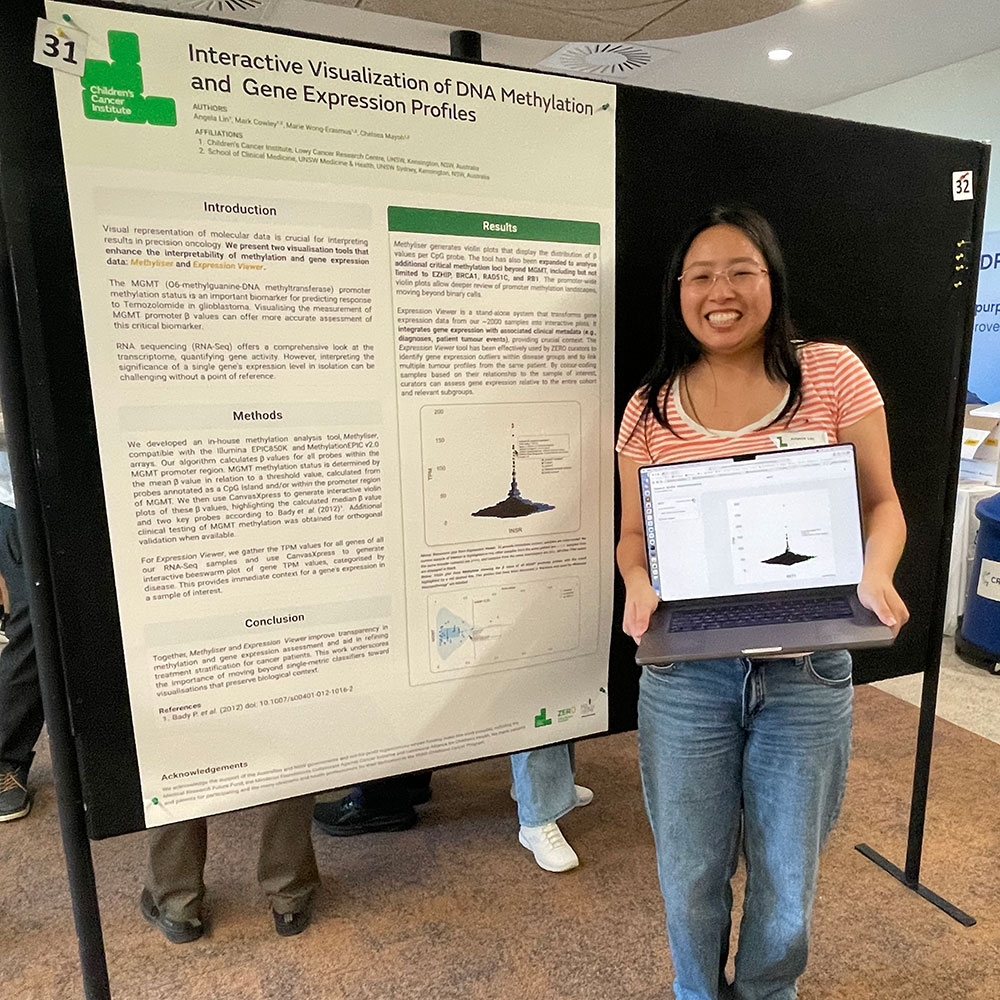My mum was diagnosed with breast cancer when I was five. In the very early stages of her treatment, I decided what I wanted to do when I grew up.
My mum was very lucky, her cancer responded to treatment and she’s alive today. Her story and our family experience were my first inspiration. Now when I hear a cancer story, it joins mum’s story in my heart, and makes the desire to make a difference even stronger.
So I’m keeping that promise to my 5-year-old self. I’m doing a PhD under the supervision of Dr Toby Trahair, a Staff Specialist in Paediatric Haematology/Oncology at Kids Cancer Centre, Sydney Children’s Hospital, Randwick, and a Clinical Research Fellow in the Embryonal Cancer Therapy and Prevention Group at Children’s Cancer Institute. I’m working on a rare childhood cancer called Inflammatory Myofibroblastic Tumour or IMT.

What is inflammatory myofibroblastic tumour?
IMT is a type of soft tissue tumour that can occur in almost any organ in the body. It’s a very rare cancer that occurs mostly in children, and its cause is largely unknown. In about half of cases, IMT is linked to a rearrangement of the anaplastic lymphoma kinase (ALK) gene.
There is no standard treatment for IMT beyond surgical removal of the tumour, because existing chemotherapy drugs are largely ineffective. Drugs that inhibit the ALK protein have been used to treat ALK-rearranged IMT, but relapse with resistant cancer is common. Effective and durable treatments for patients with relapsed IMT are urgently needed.
Creating the world’s first live cell models of IMT
Because very few children are diagnosed with IMT, as it’s such a rare cancer, there’s little information about its biology. That makes it difficult for researchers looking for better treatments. The best approach would be testing potential new drugs on live IMT cells, but this hasn’t been possible, at least until now. In what we believe to be a world-first, my colleagues and I have grown IMT cells in the lab, creating the first purified cell and mouse models of IMT. Models mimic the disease and give us an unprecedented opportunity to explore its biology.
In what we believe to be a world-first, my colleagues and I have grown IMT cells in the lab
To make these models, we collected IMT cells from patients who’d consented to contribute to our research, and developed a method for growing the cells in culture dishes in the lab. We also put some IMT cells into mice. The resulting IMT tumours have the same characteristics as the original patient tumour, giving us a unique opportunity to see which treatments might work best for children who get this disease in the future.
Using these models to find better treatments for IMT
We can now use these two live cell models to identify better treatments for IMT. One possibility we’re investigating is called CD30-targeted therapy. CD30 is a protein often found on the surface of IMT cells, but not on normal cells. Already we’ve got some exciting initial results with a drug that targets the CD30 protein.
This drug, Brentuximab, has two components – an antibody that sticks to CD30, and a ‘payload’, a chemical delivered directly to IMT cells that kills them. Brentuximab is currently used to treat two different cancers, Hodgkin and anaplastic large cell lymphoma. If further experiments in our IMT live cell models confirm it works well in IMT too, it could be fast-tracked as a potential new treatment for IMT patients.
A researcher/patient partnership
Our research is only possible because of brave children with IMT. I’ve been privileged to learn the story of one of these children, a little girl called Giulia, who was diagnosed with IMT at age seven.

After two gruelling years of treatment and surgery, Giulia has been in remission for two years. She has admitted to her mum that her greatest fear is that her cancer will come back, i.e. that it will relapse. If that happens, there’s very little doctors can do.
Giulia is a patient of Dr Trahair, my PhD supervisor. Knowing her story makes me even more determined to find a cure for this terrible disease.
Giulia and I have something in common. She’s been inspired by the research we’re doing, and thinks it would be ‘cool’ to be a scientist one day. Perhaps she’ll grow up to be a cancer researcher too!
If you’re a science student at uni and were inspired by Ash’s story and her search to find cures for cancer, maybe you could do a PhD or honours year with us. Find out how you can study with us.
Top image: PhD student Ashleigh Fordham in the lab and (inset) at age 5, when she decided she wanted to cure cancer.















